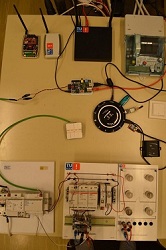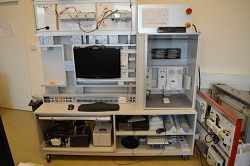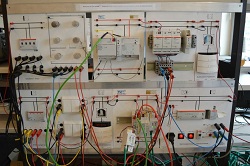 IoTSyS – Internet of Things Integration Middleware
IoTSyS – Internet of Things Integration Middleware
Contestants: Markus Jung, Jürgen Weidinger, Thomas Hofer of Vienna University of Technology and Alex Olivieri of University of Applied Sciences & Arts Western Switzerland (HESSO)
Affiliations: Vienna University of Technology and University of Applied Sciences & Arts Western Switzerland (HES-SO)
Semi-finalists
Summary
IoTSyS is an Internet of Things system stack for smart objects based on IPv6 and an integration middleware for non-IP based home and building automation systems (e.g. KNX, BACnet, ZigBee, Enocean, Wireless M-Bus). It provides a seamless integration of your existing building automation infrastructure with new IPv6 based smart objects. Use open source software and low-cost and standard hardware to operate the future Internet of Things.
The successful deployment of smart grids and smart cities require the integration of home and building automation systems, since buildings are a main energy consumer. Home and building automation systems come with heterogeneous technologies that need to be integrated and new systems should provide high interoperability to be ready for future control scenarios and “managed services” that are possible hosted in the cloud.
IoTSyS addresses this interoperability challenge by using IPv6, Web services and a common object representation based on Open Building Information Exchange (oBIX) on every device. For non-IP based devices a gateway based on the Raspberry PI together with technology connectors provides a similar interface by offering an IPv6 communication endpoint for every device. This allows to access every device with Internet Technology and to exploit end-to-end connectivity over the public Internet. It exploits the IPv6 multicast capabilities to create interaction scenarios for smart objects in order to avoid a single point of failure introduced through centralized control units.
Existing buildings and homes are equipped with non-IP technologies optimized for local control interactions. Usually an optimized and domain-specific system stack is used which creates an interoperability problem if different technologies shall be combined. The recent trend towards IPv6 communication on constrained devices within wireless sensor networks provides a solution to this problem. Furthermore, the use of interoperable Web service interfaces provide a common messaging interface and optimized protocols like the constrained application protocol these technologies can be used with reduced issues regarding resource demand and performance.
However, existing standards and solutions lack the definition of a common application layer semantic. This is addressed by IoTSyS by using the Open Building Information Exchange for expressing standardized object representations. IoTSyS contributes novel protocol bindings for oBIX including CoAP, JSON and EXI to efficiently use Web centric technologies for embedded devices in sensor and actuator systems.
The common object model provided by oBIX brings several benefits. It allows to efficiently operate EXI encoded message exchange and the common representation across all technologies makes it simple to create control logic and user interfaces. IoTSyS contributes oBIX contracts for representing standard device types.
It further comes with a novel group communication mechanism using IPv6 multicasts. IoTSyS does not only use IPv6 on every device, it uses IPv6 dedicated IPv6 multicast addresses on every data point in order to group similar devices or to group sensors, actuators and logic components. This is possible by using the normalized oBIX representation for data points and the novel protocol binding to CoAP.
Through the standard oBIX object model a generic HTML5 interface can be provided and used to create control logic to realize smart solutions.
IoTSyS can be directly deployed on Contiki based devices or operated on a Java and OSGI based gateway. It is optimized to run on a constrained device like the Raspberry PI. Protocol bundles for home and building automation systems like KNX, BACnet, ZigBee, Enocean and Wireless M-Bus are provided and standard communication modules can be used to communicate with the according bus systems. The different systems and communication models are mapped to a common object representation, which can be interfaced through various Web service protocol bindings (e.g. HTTP, CoAP, SOAP) with optimized encodings for different use cases (e.g. XML, JSON, EXI).
The privacy and security issues of using Internet technology for home and building automation system is addressed by employing the extensible access control markup language (XACML) and respective components within IoTSyS to facilitate fine-grained access control based on open technologies and standards.
IoTSyS is completely open source hosted at https://code.google.com/p/iotsys and uses standard and low-cost hardware that can be easily obtained.
With IoTSyS you can create IPv6 based control and monitoring solutions with your existing automation systems. Combine your BACnet HVAC control system with IPv6 based wireless sensor networks, integrate geographically distributed sites or move your building management as managed service to the cloud.
IoTSyS is an enabler for such scenarios and provides a smooth transition to a secure all IPv6 based Internet of Things based on smart objects.
Institute of Computer Aided Automation, Vienna University of Technology
IoTSyS emerged out of the research projects in which the Automation Systems Group of the Vienna University of Technology is involved. The Automation System Group performs research and teaching related to industrial automation, home and building automation and wireless sensor networks and is engaged in recent research trends on smart grids, smart cities and the Internet of Things.
Institute of Information Systems, Haute Ecole Spécialisée de Suisse occidentale
The Institute of Information Systems of the HES-SO Valais is closely related to the Bachelor’s and Master’s degree courses of the same name and specialises in the development of information systems for companies in any industry. The Institute is active in high value-added areas of the local economy such as eHealth, eServices (digitisation of services), eGovernment, eEnergy (energy management) or ERP.
IoT6
IoTSyS emerged as research prototype within the IoT6 European research project which aims at exploiting the potential of IPv6 and related standards (6LoWPAN, CORE, COAP, etc.) to overcome current shortcomings and fragmentation of the Internet of Things. Its main challenges and objectives are to research, design and develop a highly scalable IPv6-based Service-Oriented Architecture to achieve interoperability, mobility, cloud computing integration and intelligence distribution among heterogeneous smart things components, applications and services. Details can be found at http://www.iot6.eu
Web:
http://code.google.com/p/iotsys
Contact:


